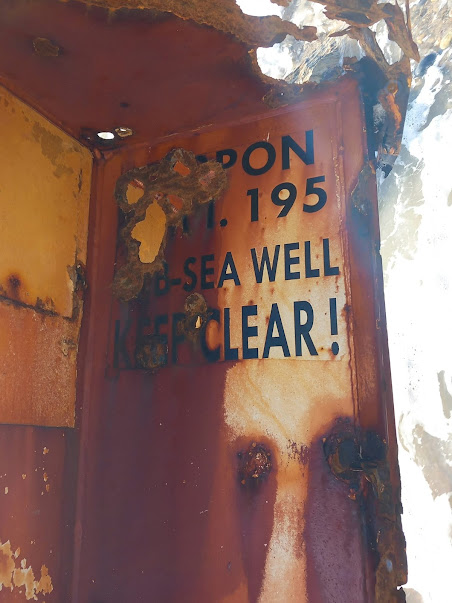(This is a little piece what I writ for Lamp 140 a few months ago, and they somehow agreed to publish it. Lamp is the journal of the Association of Lighthouse Keepers and you don't have to be a keeper to join.)
The girl from Ipanema may well go walking but, it appears, the buoy from Louisiana may well give her a run for her money. I am well aware that that sentence will not work as well in America due to their different pronunciations.
The saga began in 2005 when Hurricane Katrina rampaged through the Gulf of Mexico and caused major devastation to the southern US states. One of its victims was an oil well in the Gulf of Mexico, whose location needed to be marked. A company called Wet Tech Energy, then based in Lafayette LA, were contracted to manufacture a buoy to mark the spot. This they did and, in 2006, the buoy, affectionately named 3372899399, was placed in position and moored.
According to Todd Carl, operations manager with Wet Tech, the company realised it was missing on a regular tour of inspection in 2007. Evidently, it broke its moorings and began its wanderings on the ocean blue. One could say that the story started with Katrina and the waves.
For seventeen years, nothing more was learned of the fate of their beloved 399. Todd doubtless managed to pick up his life and continue as best he could. The old place in Lafayette evidently held too many memories, so the company relocated to Youngsville.
But then, in early April 2024, he was contacted by a man called Owen J Dunbar of Ballymoney, county Wexford on the southeastern shoreline of Ireland. 3372899399 had washed up on the beach there after seventeen years adrift.
I heard about the buoy being washed ashore here at Seafield beach in Ballymoney, said Owen, and I managed to see a serial number on it and the name of the company, Wet Tech, who are from Youngsville, Louisiana.
Ever since 2007, the buoy has been on the Gulf Stream, or the North Atlantic
Drift, as it is called. So its probably not the first time that it passed the
Irish coast because the Gulf Stream is like a washing machine that keeps going
round and round. As one might expect from spending seventeen years in a
washing machine, the buoy is very clean but all the colour has been washed out
of it.
The artist formerly located at Sub-sea well, Block 195
Owen got in touch with Todd and told him the joyous
news. He also contacted the local news group, Broussard-Youngsville Local News
(BYLN) who relayed the tidings to the population of Louisiana
Owen, though, was worried. Storm Kathleen was about
to break on the Wexford shoreline and it was entirely possible that the sea
might try to reclaim what it regarded as rightfully her’s. Prayers were said
and a candlelight vigil took place, though it didn’t work too well in the
gale-force winds. As it happened, the storm only succeeded in pushing 399
further up the beach.
On Aprill 11th, according to their
website, BYLN met with Todd Carl, operations manager, and Paul Anderson,
vice president of operations at Wet Tech. Anderson informs BYLN that this
morning, he received a request from Aidan Bates, a dedicated marine officer
with the Wexford coastline, who is working to move the buoy. Bates has
requested a drawing of the buoy to know where the lifting eyes are, a crucial
detail for the removal process.
At
time of writing, the buoy is still there on the beach, although some lovely
person or persons has already removed the solar light from its top. Its fate
seems to be that it will be removed from the beach, whether by land or by sea.
Todd is apparently too emotionally drained to want it back and locals have been
speculating about its future. A feature on a local roundabout, perhaps? A
beachside pedestal with an information plaque? Maybe it could even be used as a
buoy?
Or,
as one local remarked, if there was another one, it would make a nice pair of
earrings.

All photos of the Ballymoney buoy courtesy Owen J. Dunbar
Since that article was published, I have learnt that the Ballymoney buoy was not the first transatlantic visitor to our shores. I came across this article in an old Beam magazine about a similar buoy that quit America at around the same time as Owen Dunbar's baby. It washed ashore from the eastern seaboard of the US at Furbo, co. Galway.
And, prior to that, around 1991, a US Coastguard Buoy washed up in Killala. For some reason, the Americans didn't feel like sending out a boat to bring it back so it lay in a field for nearly twenty years, warning cows of the dangerous rocks. Then, in 2010, Mayo County Council took it in, gave it a bath and some clean clothes and installed it in position near the Black Rocks at the entrance to Killary Harbour.
The Killala Buoy tried working on land but the sea was always in his blood (photo Tim Ryan)
In 2016, an eco-houseboat from Newfoundland washed up on the Mullet peninsula in Mayo, having apparently broke her moorings in Canada. Inside they found a handwritten note from the owner donating it to a homeless person. It was, however, in not quite the same condition as the picture below.
And in 2019, a US Coastguard boat made a sudden appearance between Doolin, co. Clare, and Inis Oirr, co. Galway, looking rather the worse the wear after being in the washing machine for some time. Judging by the length of the goose barnacles on it, it had been several years adrift.










Comments
Post a Comment